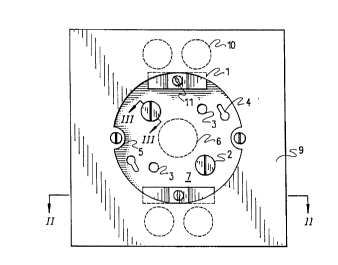Some of the information on this Web page has been provided by external sources. The Government of Canada is not responsible for the accuracy, reliability or currency of the information supplied by external sources. Users wishing to rely upon this information should consult directly with the source of the information. Content provided by external sources is not subject to official languages, privacy and accessibility requirements.
Any discrepancies in the text and image of the Claims and Abstract are due to differing posting times. Text of the Claims and Abstract are posted:
| (12) Patent: | (11) CA 2028929 |
|---|---|
| (54) English Title: | ELECTRIC JUNCTION BOX/OUTLET |
| (54) French Title: | BOITE DE DERIVATION/PRISE ELECTRIQUE |
| Status: | Deemed expired |
| (52) Canadian Patent Classification (CPC): |
|
|---|---|
| (51) International Patent Classification (IPC): |
|
| (72) Inventors : |
|
| (73) Owners : |
|
| (71) Applicants : | |
| (74) Agent: | |
| (74) Associate agent: | |
| (45) Issued: | 1998-02-03 |
| (22) Filed Date: | 1990-10-30 |
| (41) Open to Public Inspection: | 1992-03-19 |
| Examination requested: | 1994-01-12 |
| Availability of licence: | N/A |
| (25) Language of filing: | English |
| Patent Cooperation Treaty (PCT): | No |
|---|
| (30) Application Priority Data: | ||||||
|---|---|---|---|---|---|---|
|
A junction box for connection to the electrical wiring of
a building structure includes an inner panel adapted for mounting
to a surface of a building structure and an outer panel
substantially parallel to and spaced from the inner panel and
adapted for mounting an electrical device thereon. Side panel
means bridge the inner and outer panels to provide an enclosure
therebetween. The inner panel is adapted to permit passage of
an electrical conduit therethrough, and the outer panel is
adapted to permit access to the electrical conduit for connection
of an electrical device thereto.
Boîte de jonction du câblage d'un bâtiment constituée d'un panneau interne devant être monté sur une surface du bâtiment et d'un panneau externe sensiblement parallèle au premier, dont il est séparé par un intervalle, sur lequel on peut monter un dispositif électrique. Une structure placée sur le côté du panneau établit un pont entre ces panneaux interne et externe pour former une enceinte entre les deux. Le panneau interne est conçu pour pouvoir être traversé par une canalisation électrique, et le panneau externe pour laisser libre accès à cette canalisation de manière à ce que l'on puisse y connecter un dispositif électrique.
Note: Claims are shown in the official language in which they were submitted.
Note: Descriptions are shown in the official language in which they were submitted.

For a clearer understanding of the status of the application/patent presented on this page, the site Disclaimer , as well as the definitions for Patent , Administrative Status , Maintenance Fee and Payment History should be consulted.
| Title | Date |
|---|---|
| Forecasted Issue Date | 1998-02-03 |
| (22) Filed | 1990-10-30 |
| (41) Open to Public Inspection | 1992-03-19 |
| Examination Requested | 1994-01-12 |
| (45) Issued | 1998-02-03 |
| Deemed Expired | 2004-11-01 |
There is no abandonment history.
| Fee Type | Anniversary Year | Due Date | Amount Paid | Paid Date |
|---|---|---|---|---|
| Application Fee | $0.00 | 1990-10-30 | ||
| Maintenance Fee - Application - New Act | 2 | 1992-10-30 | $50.00 | 1992-09-28 |
| Maintenance Fee - Application - New Act | 3 | 1993-11-01 | $50.00 | 1993-10-18 |
| Maintenance Fee - Application - New Act | 4 | 1994-10-31 | $50.00 | 1994-10-07 |
| Maintenance Fee - Application - New Act | 5 | 1995-10-30 | $75.00 | 1995-10-13 |
| Maintenance Fee - Application - New Act | 6 | 1996-10-30 | $75.00 | 1996-10-03 |
| Final Fee | $150.00 | 1997-09-09 | ||
| Maintenance Fee - Application - New Act | 7 | 1997-10-30 | $75.00 | 1997-09-09 |
| Maintenance Fee - Patent - New Act | 8 | 1998-10-30 | $75.00 | 1998-10-30 |
| Maintenance Fee - Patent - New Act | 9 | 1999-11-01 | $75.00 | 1999-10-29 |
| Maintenance Fee - Patent - New Act | 10 | 2000-10-30 | $100.00 | 2000-10-27 |
| Maintenance Fee - Patent - New Act | 11 | 2001-10-30 | $300.00 | 2002-10-15 |
| Maintenance Fee - Patent - New Act | 12 | 2002-10-30 | $100.00 | 2002-10-15 |
Note: Records showing the ownership history in alphabetical order.
| Current Owners on Record |
|---|
| STUMM, ERIC |
| Past Owners on Record |
|---|
| None |